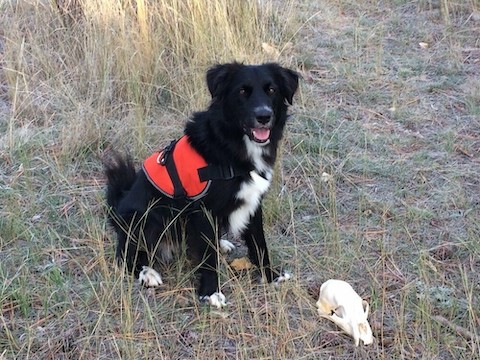
Credit: Lauri Travis
If, like me, you think dogs are amazing, you’ll be even more amazed to learn they experience life in four dimensions—through their noses.
Dogs have an olfactory bulb 40 times larger than ours, with hundreds of millions more receptors.
They use that super-sniffer to build a three-dimensional smell map of their surroundings. Sort of like an interactive 3D computer model.
To that, they add a fourth dimension: time. They can smell how a scent has fallen in concentration, or oxidized and changed in character, to understand when something passed by, or an event occurred.
Because of these spectacular abilities, we’ve trained dogs for a variety of science “careers.”
Medical dogs can detect diseases, pregnancy or allergens—or when an episode of epilepsy or diabetes is about to come on.
Dog detectives help police and soldiers track criminals or enemy combatants and find drugs and explosives.
Disaster dogs hunt for survivors after avalanches and earthquakes. Cadaver dogs find bodies below water, soil and concrete.
Archaeology dogs have discovered human remains from 3,000 years ago!
Conservation dogs can locate endangered animals or invasive species.
Meteorite dogs can even find materials from outer space.
Through these tasks, we can access dogs’ four-dimensional scent maps, to know the world as they nose it.
Background
Synopsis: Dogs and humans have worked together for tens of thousands of years, but today canine experts are fetching a lot of attention as essential scientific assistants. Their super-sniffer power makes them perfect partners for doctors, detectives, and other scientists. Although researchers have tried, they have not been able to robotically duplicate the canine sense of smell. From medical detection to forensic science to archaeology and meteorite hunting, the dog’s nose knows!
- Dogs and humans have partnered up to track and hunt prey for more than 30,000 years.
- We have talked about this long-term friendship, and how it influenced the evolution of both dogs and humans over time, before (ED-078 Best Friends Forever).
- Many hunting dogs begin formal training when they are 6 or 7 months old.
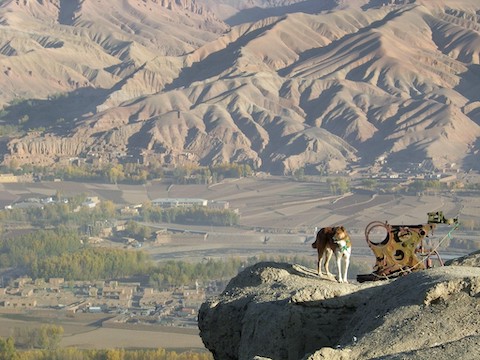
Credit: Carl Montgomery, via Wikimedia Commons
- Today, working dogs fill many critical roles that employ their inimitable sense of smell.
- Dog detectives help police and soldiers by tracking missing people, hostages, criminals or enemy combatants as well as finding drugs, firearms and explosives.
- Medical dogs can detect diseases like cancer, malaria and COVID-19. They can also warn if epileptic or narcoleptic patients are on the verge of a seizure and can detect the onset of diabetic and migraine episodes by sensing metabolic changes caused by these diseases. Dogs can identify pregnancy in humans and livestock and can even sense peanuts in food to protect those with allergies.
- Disaster dogs hunt for survivors after emergencies like avalanches, landslides, earthquakes, building collapses, explosions and floods, while cadaver dogs specialize in finding human remains even if they are below water, soil or concrete.
- Archaeology dogs have tracked down human remains from more than 3,000 years ago by sensing fat molecules remaining from human decomposition, helping their human partners to find new archaeological dig sites.
- Conservation dogs can locate specific endangered animal species and can find invasive species of plants and animals in natural settings.
- Meteorite dogs are trained to help meteorite hunters find extraterrestrial material for scientific study.
- The canine sense of smell is much more sensitive than human olfaction.
- Dogs can smell odors from distances as far as 50 yards (~50 m) to 1 mi (~1,600 m), depending on conditions and dog breed.
- Dogs can detect extremely low concentrations of scents.
- What we can smell from across a room, dogs can smell from across a stadium.
- If humans had such sensitivity, it would be the equivalent of tasting one-half teaspoon of sugar in an Olympic-sized swimming pool.
- Dogs can differentiate a staggering number of scents. For them, every whiff of air has a distinct odor profile.
- Relative to total brain size, the canine olfactory bulb is 40 times larger than the human olfactory bulb.
- Olfactory analysis accounts for about one-third of a canine brain’s work.
- Canine olfactory signals are connected directly to the brain centers for emotion and insight so that their reception of scent can be immediate and visceral, while slower human olfaction must be processed through the thalamus first.
- While humans are visual creatures, using our eyes to construct a three-dimensional (3D) mental picture of our visual environment, dogs use their noses to construct a swirling scented vision of their olfactory world and can even reconstruct a sequence of events in a particular location through time—resulting in a 4D view.
- Dogs smell with each nostril separately and can move their nostrils independently to quickly identify the source of a particular odor.
- The cold, wet canine nose helps to capture scent particles.
- As air enters a dog’s nasal cavity, it is separated into two streams, with about 88% heading to the lungs for respiration and 12% routed to a special olfactory-sensing chamber just for smelling, connected directly to emotional centers in the brain.
- Outgoing air exits via the side slits of a dog’s nostril, enabling the dog to breathe in scent even while it is exhaling. The side slits swirl the outgoing air to stir up additional scent molecules.
- Dogs track best in spring and fall, when air is cooler than the ground. Light rain is known to further enhance their ability to detect odors.
- Dogs can even sense the movement of time as aromas evolve through the day with hot air rising and carrying odors upward.
- Some dogs have been known to do punctual tasks, like picking up their masters at schools or train stations, every day for years.
- Dogs can tell which direction the source of an aroma was moving in the past by distinguishing stronger, more recent scents from waning, weaker scents.
- Dogs may weave back and forth as they are reconstructing the history of a particular scent in a location.
- Dogs can also lift their nostrils into the breeze to sense incoming future events.
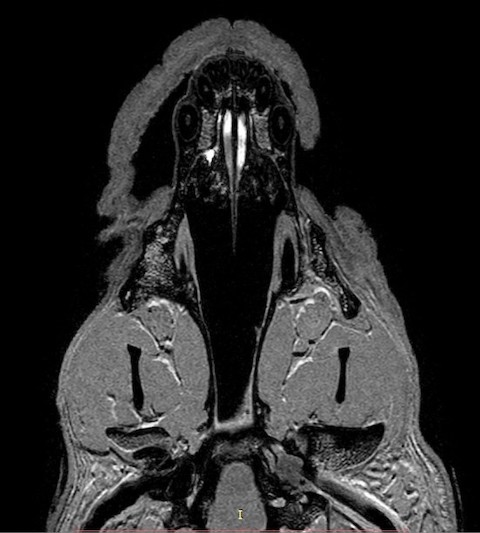
Credit: Dzięcioł and others, Frontiers in Veterinary Science
- Dogs have a second sense of smell that comes from an additional olfactory organ.
- The vomeronasal organ is located below the nasal cavity but above the roof of a dog’s mouth and is also directly connected to centers of insight in the brain.
- Also known as the Jacobson’s organ, it detects the chemical essences of pheromones released by other animals, enabling dogs to find mates, locate their puppies, detect pregnancy in mammals and distinguish happiness, fear, anger and grief in humans.
- Humans have the vestiges of this organ, but it is nonfunctional.
- Dogs visit their favorite fire hydrants or neighborhood trees to pick up neighborhood news and messages from other dogs about when they last visited the spots, what they’ve been eating, and how they are feeling.
- Dogs can be trained to sense specific smells with rewards
- Explosive-sniffing dogs can sense one-trillionth of a gram of TNT.
- Scent-tracking dogs can ignore thousands of other smells to keep on the scent of their target, catching whiffs from the ground and the wind.
- You can teach your dog to track other pets or family members, or to help you hunt.
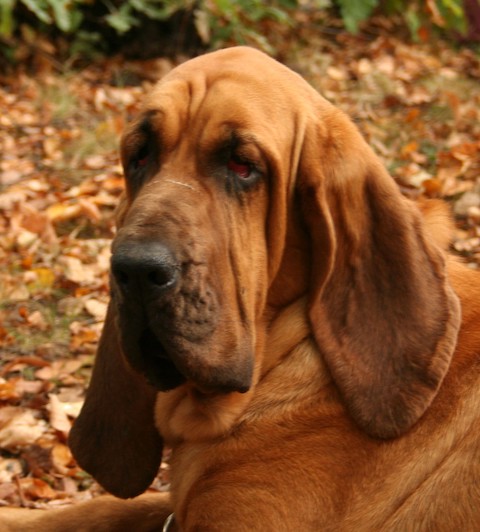
Credit: Pleple2000, via Wikimedia Commons
- Depending on breed, Dogs have 20 to 50 times the number of olfactory receptor cells as humans, ranging from 125 million to 300 million compared to the paltry 5 million to 6 million receptors in humans.
- Dogs with longer snouts, like bloodhounds, have more receptors, so they can smell better than dogs with shorter snouts, like bulldogs.
- Bloodhounds specialize in animal and human tracking.
- German shepherds are best at locating bombs and drugs.
- Labrador retrievers excel at detecting medical issues.
- Beagles work with customs officials as agricultural sleuths at many airports.
- Dogs also work in important roles as guide dogs and emotional support dogs that are less tied to their senses of smell.
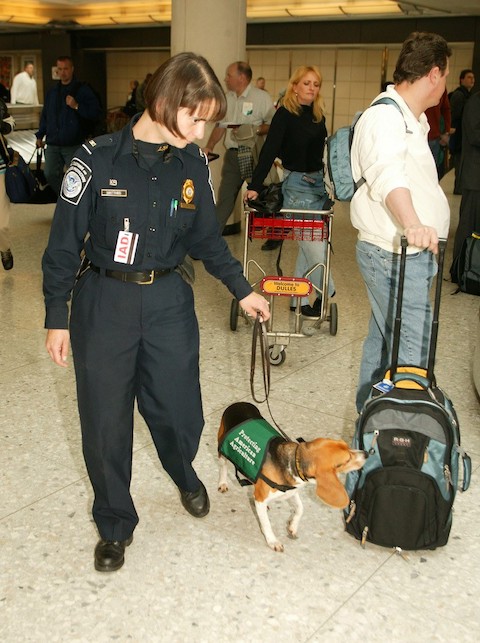
Credit: James Tourtellotte, U.S. Customs and Border Protection, via Wikimedia Commons
- Many myths about evading tracking dogs have been perpetuated by old movies.
- If you were thinking about evading tracking dogs by running through water, it won’t work—dogs can smell scents that originate in and under water. One pup can guide her humans by boat to orca poop in the ocean from a mile away.
- Search and rescue dogs can detect scents buried underground and inside of cement, even if the source of the scent is 15 ft below the surface.
- New studies have shown that dogs can also detect weak thermal radiation using the moist, cold tips of their noses. This capability probably evolved for hunting.
- Biomechanical engineers have been successful at imitating a gecko’s grip and a mosquito’s bite, but they have not yet been able to engineer the indispensable capabilities of a dog’s super-sniffer.

